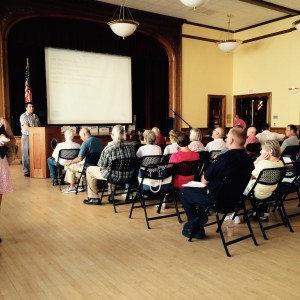On August 1, approximately 35 residents and town officials met in the Marion Music Hall with the Southeastern Regional Planning and Economic Development District’s (SRPEDD) municipal planning group for a continuation of public discussions aimed at helping the town create a master plan. Grant King, principal comprehensive planner/information specialist for SRPEDD, was the facilitator for this second meeting titled “Marion Master Plan Workshop on Land Use, Economic Development, and Climate Resiliency.”
Marion had sought and received grant monies to secure the services of SRPEDD in their effort to drill through all the layers of issues and desires the town’s residents identify as critical areas as they attempt to craft plans for a viable and successful future in a world wrought with uncertainty. This second public meeting is one of nine stages towards the development of a master plan.
King reminded the assembled that the key areas of importance previously identified by the residents were: Route 6 and Front Street being pedestrian-friendly and maintaining a “village-like” appearance; the need for parking, especially in the village; and land use from open spaces to full blown development.
King said data should drive decisions. He then provided some data points.
Regarding the average age of year-round residents, King said that in 1990 that number was 36 years of age, and by 2014 it was 46 – a striking aging of the overall population, King stated. By contrast, he said that age number is the oldest of all the communities SRPEDD serves. Concurrent with that information, he said elementary school enrollment had declined. Of the total population, he said 36 percent were 65 years or older.
On the issue of land use, King pointed to the large amount of land in a non-tax or reduced-tax status in Marion. Tabor does not pay real estate taxes due to its institutional status, while lands held in agricultural or foresting categories, known as “chapter lands,” pay vastly reduced rates, he pointed out. A stunning 93 percent of the town’s entire tax base comes from real estate taxes imposed on less than 50 percent of the land within the town boundaries. Highlighting the way in which land is currently used in Marion, King told the group that residential use comprises 37 percent, institutional 31 percent, chapter lands 22 percent, while commercial/industrial stands at 3 percent.
Climate change was also discussed as a significant issue for a seaside community such as Marion. A 40-year projection from NOAA visually mapped by SRPEDD showed much of Marion under water in just a few decades. King said the town would need to think about a “managed retreat” at some point in the not too distant future.
During a break in the presentation, Zoning Board of Appeals and Board of Health member Betsy Dunn said, “I’m not sure we can reach a consensus, but I am hopeful,” when asked if she thought the town could come together and create a good plan.
Long-time resident Elizabeth Brainard echoed that sentiment, adding, “If we have a clear vision of how to make the changes.” Brainard also had high praise for the work done by the SRPEDD team.
Norman Hills, who sits on the Planning Board and the Conservation Commission for the town, said changes to the zoning bylaws were absolutely necessary in order to make a plan work. He said expenditures identified by the Capital Improvement Committee didn’t take SRPEDD data into consideration.
“Five fundamental things,” said Hills, need to be identified versus a “laundry list” of goals that was unachievable. He also pointed to waste management as a restriction, a problem when considering development. And continuing on the theme of waste management, Hills said most of the town was on septic systems. Rising seawater meant rising water tables, even in upland locations, affecting vast numbers of residences. “Including mine,” said Hills.
After the group brainstormed and provided the SRPEDD team with numerous hopes, dreams, and ideas for the town, King told the group that his team would distill all the feedback and return with a report on the meeting. This feedback will help to fuel future workshop-style meetings, which are planned for October 17 and December 1.
Hills said the goal is to have a plan by summer 2016. The town’s current funding for this work ends at the close of December 2015. He said they would apply for another grant to complete this study.
All public comments from this second meeting need to be submitted to SRPEDD by 5:00 pm on August 21. For more information on how you can participate in the process, visit www.srpedd.org/marion-master-plan or go to www.facebook.com/marionplan. Grant King’s contact information is gking@srpedd.org or 508-824-1367, ext. 318. You may also contact the Marion Planning Board via email to tsantos@marionma.gov or call 508-748-3517.
By Marilou Newell
